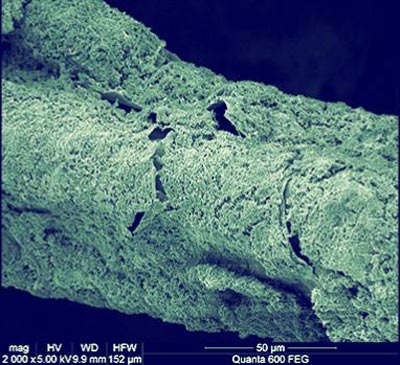Lighting the path to recycling carbon dioxide

SEM image shows the dense and uniform cathodic biofilm, which mainly comprises chemolithoautotrophs, and could serve as biocatalysts for efficient carbon dioxide conversion to acetate.
Credit: © 2020 KAUST
Semiconductive photocatalysts that efficiently absorb solar energy could help reduce the energy required to drive a bioelectrochemical process that converts CO2 emissions into valuable chemicals, KAUST researchers have shown.
Recycling CO2 could simultaneously reduce carbon emissions into the atmosphere while generating useful chemicals and fuels, explains Bin Bian, a Ph.D. student in Pascal Saikaly’s lab, who led the research. “Microbial electrosynthesis (MES), coupled with a renewable energy supply, could be one such technology,” Bian says.
MES exploits the capacity of some microbes to take up CO2 and convert it into chemicals, such as acetate. In nature, chemolithoautotroph microbes metabolize minerals as a source of energy in a process that involves the shuttling of electrons. This capability can be exploited to turn CO2 into value-added products if the microbes are supplied with a stream of electrons and protons from anodic water splitting in an electrochemical cell (see image).
In their latest work, rather than focus on the CO2-to-acetate step, the team worked on reducing the energy input for molecular oxygen (O2) production at the anode, a reaction that keeps the overall cell in balance. “In MES systems, the process that consumes the most energy is believed to be the oxygen evolution reaction (OER),” Bian explains. Researchers have used light-capturing anode materials, such as titanium dioxide, that harness energy from sunlight to help drive the OER. In their current work, the team investigated a promising alternative for the photoanode, the light-harvesting material, bismuth vanadate.
Bismuth vanadate absorbed energy from a much broader range of the solar spectrum than titanium dioxide, making the whole MES cell more efficient, the team showed. “We obtained solar-to-acetate conversion efficiency of 1.65 percent, which is the highest reported so far,” Saikaly says. “This efficiency is around eight times higher than the 0.2 percent efficiency of global natural photosynthesis, which is nature’s solar-powered process for converting CO2 into energy-rich molecules,” Bian notes.
So far the team has kept the microbe biocatalysts supplied with a steady stream of electrons and CO2 to sustain their growth. “The next step for us is to test our system under real sunlight and monitor the resilience of the biocatalysts under an intermittent renewable energy source,” Saikaly says.
Media Contact
All latest news from the category: Power and Electrical Engineering
This topic covers issues related to energy generation, conversion, transportation and consumption and how the industry is addressing the challenge of energy efficiency in general.
innovations-report provides in-depth and informative reports and articles on subjects ranging from wind energy, fuel cell technology, solar energy, geothermal energy, petroleum, gas, nuclear engineering, alternative energy and energy efficiency to fusion, hydrogen and superconductor technologies.
Newest articles

A universal framework for spatial biology
SpatialData is a freely accessible tool to unify and integrate data from different omics technologies accounting for spatial information, which can provide holistic insights into health and disease. Biological processes…

How complex biological processes arise
A $20 million grant from the U.S. National Science Foundation (NSF) will support the establishment and operation of the National Synthesis Center for Emergence in the Molecular and Cellular Sciences (NCEMS) at…

Airborne single-photon lidar system achieves high-resolution 3D imaging
Compact, low-power system opens doors for photon-efficient drone and satellite-based environmental monitoring and mapping. Researchers have developed a compact and lightweight single-photon airborne lidar system that can acquire high-resolution 3D…





















